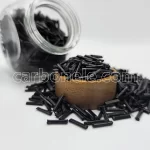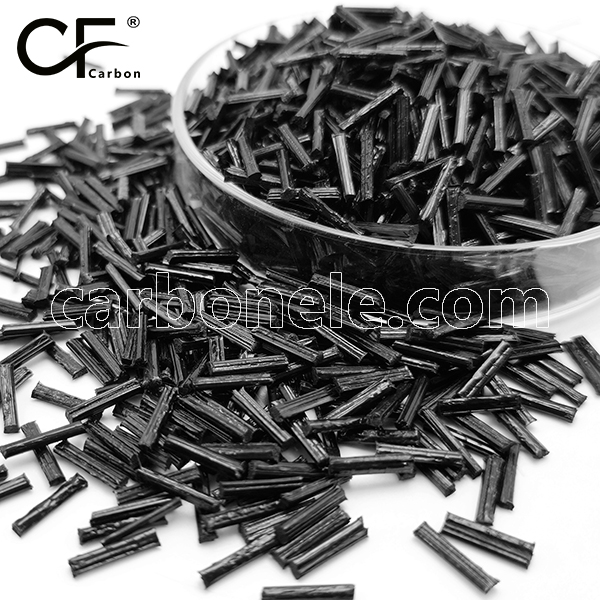
Competitive Price PA6 LCF30 Composites
PA6 LCF30 represents a significant advancement in composite materials, offering enhanced mechanical properties, lightweight characteristics, and versatility for a wide range of applications across industries. Ongoing developments and trends indicate continued growth and innovation in utilizing 30%LCF PA6 to meet evolving performance requirements and sustainability goals.
- Manufacturer: Carbon New Material
- OEM/ODM: Acceptable
- Color: Black
- Free Samples: ≤25kgs
- MOQ: 100kgs
- Port: Xiamen
- Model No.: PA6-LCF-BCA3
What’s it?
PA6 LCF30, which stands for Polyamide 6 Long Carbon Fiber reinforced with 30%, is a high-performance composite material that combines the robust properties of polyamide with the enhanced mechanical characteristics imparted by long carbon fiber reinforcement. This blend offers a range of features suitable for demanding applications across various industries, alongside current trends shaping its use and development.
Why to choose it?
1. Mechanical Strength:
– 30% carbon fiber filled PA6 exhibits superior mechanical strength compared to standard PA6. The inclusion of 30% long carbon fibers enhances its tensile strength, flexural strength, and impact resistance. This makes it suitable for structural applications where durability and reliability are paramount.
2. Stiffness and Rigidity:
– The presence of long carbon fibers significantly improves the stiffness and rigidity of PA6 LCF30%. This property is crucial in applications requiring components to withstand mechanical stress without deformation or sagging, contributing to dimensional stability.
3. Lightweight:
– Despite its enhanced mechanical properties, PA6-LCF30 remains lightweight. This characteristic is advantageous in industries such as automotive and aerospace, where reducing weight can improve fuel efficiency, reduce emissions, and enhance overall performance.
4. Chemical Resistance:
– PA6 with 30% LCF reinforced retains the chemical resistance inherent to polyamide. It withstands exposure to oils, greases, fuels, and various chemicals, making it suitable for applications in automotive, industrial, and chemical processing environments.
5. Thermal Stability:
– The addition of long carbon fibers enhances the thermal stability of PA6 LCF30%. It exhibits improved resistance to heat distortion and maintains its mechanical properties over a broad temperature range, making it suitable for applications exposed to fluctuating temperatures.
6. Dimensional Accuracy:
– LCF30% PA6 offers excellent dimensional accuracy and stability due to the reinforcement of long carbon fibers. This property ensures that molded parts maintain their shape and size, even under varying mechanical loads and environmental conditions.
7. Electrical Properties:
– PA6 LCF30 maintains good electrical insulation properties similar to standard polyamide. It is capable of withstanding electrical currents and provides reliable insulation in electrical and electronic applications.
8. Surface Finish:
– The incorporation of long carbon fibers can influence the surface finish of molded parts. With proper processing techniques, PA6 LCF30% can achieve a smooth surface finish suitable for both functional and aesthetic applications.
9. Processability:
– PA6 LCF 30 can be processed using standard injection molding techniques, which facilitates its integration into existing manufacturing processes. This ease of processability allows for efficient production of complex geometries and customized components.
Where to use it?
1. Automotive Industry:
– 30%LCF PA6 finds extensive use in automotive applications, including structural components, under-the-hood parts, and interior components. Its combination of high strength, lightweight nature, and chemical resistance makes it suitable for improving vehicle performance and efficiency.
2. Aerospace and Aviation:
– In aerospace applications, PA6+LCF30 is used for structural components, cabin interiors, and aircraft equipment. Its mechanical strength, stiffness, and thermal stability make it suitable for both interior and exterior aerospace applications where lightweight materials with high performance are required.
3. Industrial Equipment:
– PA6 LCF30 is employed in industrial machinery and equipment for components that require strength, durability, and resistance to wear and tear. It withstands mechanical stresses and harsh operating conditions encountered in industrial settings.
4. Consumer Goods:
– Consumer goods benefit from PA6+LCF30 in products such as sporting equipment, electronic housings, and household appliances. Its enhanced mechanical properties and lightweight nature contribute to durability and performance in everyday use.
5. Electrical and Electronics:
– PA6+LCF30 is utilized in electrical enclosures, connectors, and housings due to its electrical insulation properties and mechanical strength. It provides protection for electronic components while ensuring reliability in electrical and electronic applications.
Trends in PA6 LCF30% Development
1. Increased Use in Lightweighting Efforts:
– As industries continue to prioritize lightweighting for improved efficiency and sustainability, PA6 LCF30% is increasingly being adopted to replace traditional materials like metals in various applications.
2. Advancements in Fiber Reinforcement Technology:
– Ongoing research focuses on optimizing the alignment and dispersion of long carbon fibers within the PA6 matrix to further enhance mechanical properties and ensure consistent performance in different applications.
3. Expansion into New Application Areas:
– PA6 LCF30 is expanding beyond traditional automotive and aerospace applications into sectors such as renewable energy, where its lightweight and durable properties can benefit wind turbine components and solar panel structures.
4. Focus on Sustainable Materials:
– There is a growing emphasis on developing sustainable versions of PA6 LCF30% by incorporating recycled carbon fibers and bio-based polyamides. This trend aligns with global efforts to reduce environmental impact and promote circular economy principles.
5. Integration of Smart Manufacturing Technologies:
– Smart manufacturing technologies, including digital twin simulations and additive manufacturing (3D printing), are being utilized to optimize the design and production of PA6 LCF30% components, enhancing efficiency and reducing time to market.
If you would like this product, kindly let me know, please.
Learn more about LCFRTPs, please click here or watch videos.
Carbon Fiber Models
Carbon fiber models: T300, T700, T800, etc. The tensile strength is several times that of steel and can withstand extreme mechanical loads and impacts. The tensile strength of T800 carbon fiber is as high as 5800 MPa. When combined with thermoplastic resin, it can effectively improve the overall mechanical properties of composite materials, giving them higher load-bearing capacity and deformation resistance.

Frequently Asked Questions
Carbon (Xiamen) New Material Co., Ltd. aims to provide buyers with "one-stop" worry-free high-quality services. Here you can find all information about carbon fiber engineering plastics. If you still have questions, please send us an email for consultation!
-
How can I contact the manufacturer of a product that interests me?
When you find a product you are interested in, you can contact the manufacturer directly by sending an email and we will get back to you as soon as possible.
-
How do I find the products that interest me?
All you need to do is enter the keyword, product name in the search window and press the Enter key on your keyboard. Your search results page will then be displayed. You can also search within the product category pages on the home page. Each category is divided into subcategories, allowing you to refine your search and find products that interest you.
-
Where will I find a buying guide?
Please contact our after-sales service directly and we will provide you with a comprehensive operating guide.
-
What are CF Reinforced Thermoplastic Composites?
CF Reinforced Thermoplastic Composites are materials where carbon fibers are incorporated into a thermoplastic matrix. They combine the strength and stiffness of carbon fibers with the processability and recyclability of thermoplastics. For instance, they are used in automotive parts like bumper beams.
-
What are the benefits of CF Reinforced Thermoplastic Composites over traditional composites?
The key benefits include faster production cycles, easier recyclability, and better impact resistance. They also offer design flexibility. An example is in the manufacturing of consumer electronics casings where complex shapes can be achieved more easily.
-
How are CF Reinforced Thermoplastic Composites processed?
Common processing methods include injection molding, extrusion, and compression molding. Injection molding is widely used for mass production. For example, in the production of small components for the medical industry.
-
What industries use CF Reinforced Thermoplastic Composites?
They are utilized in aerospace, automotive, medical, and sports equipment industries. In aerospace, they can be found in interior components. In the medical field, they might be used in prosthetics.
-
How does the carbon fiber content affect the properties of the composites?
Higher carbon fiber content generally leads to increased strength and stiffness but may reduce ductility. A moderate content is often balanced for specific applications. For example, a higher content might be preferred in structural parts of a race car.
-
What are the challenges in using CF Reinforced Thermoplastic Composites?
Challenges include higher material costs, complex processing equipment requirements, and ensuring uniform fiber dispersion. Issues with adhesion between the fibers and the matrix can also arise. An example is in achieving consistent quality in large-scale production.


























